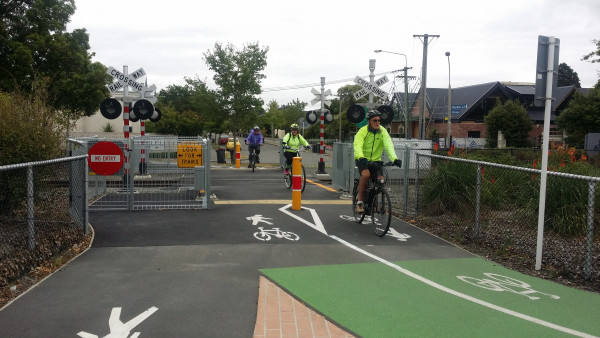This section covers pedestrian (and often also cycle) crossings of any kind over railway corridors. Although railway crossings are rare compared with road crossings, pedestrians can feel extremely apprehensive when using them.
The Traffic Control Devices Manual Part 9 Level Crossings covers pedestrians only briefly and is light on cycling facilities. As a result, the approach to choosing rail crossing treatments for these users has been ad hoc in the past, and there is limited evidence that they have been based on a consistent or objective understanding of risk.
Level crossings (Part 9 in the Traffic Control Devices Manual)
A specific technical guide for pedestrian and cycle facilities at rail crossings, both stand-alone and alongside roadways has been prepared. This guide should be used for detailed design guidance of pedestrian rail crossings in New Zealand.
Design guidance for pedestrian and cycle rail crossings (KiwiRail website)(external link)
Trains can travel quickly, are very intimidating and are unable to stop suddenly or swerve to avoid a collision. There are three types of crossing:
Examples of a pedestrian level crossing and a shared use level crossing are shown in the photos below.
The advantages and disadvantages of grade separated and level crossing facilities are similar to those across roads.
PNG: Grade separated crossings

Pedestrian level crossing at Grove Road, Christchurch. (Photo: Glen Koorey)

Shared path and automatic pedestrian gates at Matai Street, Christchurch. (Photo: Glen Koorey)
Section 9 of the Land Transport Rule: Traffic Control Devices sets out the mandatory and optional requirements for level crossings on roads and paths (both public and private); the details are also covered further in the Traffic Control Devices Manual Part 9. Note that crossings of light rail lines are not considered in this legislation.
Land Transport Rule: Traffic Control Devices 2004
Traffic Control Devices Manual Part 9: Level crossings
It is important to appreciate too that, under section 80 of the Railways Act 2005, the default presumption is always that rail vehicles have right of way along a line, and all other parties must keep clear of a railway line when trains are passing level crossings. Therefore, all steps should be taken to design level crossings to make other parties aware of their obligations.
Historically, there have been two situations in which the need for a level crossing has arisen, either when a new road or path is built across an existing railway line or when a new railway line is built across an existing road or path. This has resulted in two broad categories of level crossing – statutory and deed of grant (of right of way). The Traffic Control Devices Manual Part 9 provides further information on this.
Rail corridor operators (predominantly KiwiRail in New Zealand) seek to minimise the number of level crossings so the need for any additional crossings will have to be discussed with them from the outset to gain their consent.
New at-grade railway crossings must be carefully considered, as KiwiRail do not encourage the provision of additional crossing points on the rail network. It may be that one crossing needs to be closed to allow for another crossing to be created. Refer to KiwiRail’s Guidance for Applicants for further information.
KiwiRail: Applications for new rail crossings – guidance for applicants(external link)
Level crossings and grade separated crossings should be as convenient as possible for pedestrians and, where possible, follow the natural desire line. There have been cases in New Zealand where pedestrians have found it more convenient to cross the tracks as trespassers at-grade, putting themselves at risk of being hit by trains.
It is important to take into account railway tracks that are close to new developments. During planning for new areas, locate developments so that pedestrian and other desire lines can utilise natural features such as railway cuttings and embankments to facilitate grade separation. For significant new developments near existing railway lines, consider how pedestrians will gain access across the railway lines. New railway crossings may be necessary so it is important to involve the rail corridor operator from the outset.
There are several design issues to address for locations where pedestrians cross a railway line at-grade. The key considerations are to ensure pedestrian awareness of a rail crossing (and the presence of any trains) and to create a design that encourages compliance with any crossing controls. More detailed design guidance can be found in the Waka Kotahi/KiwiRail design guidance which provides more up to date guidance for pedestrians than the TCD Manual Part 9.
Design guidance for pedestrian and cycle rail crossings
KiwiRail also provide information on Level Crossing Safety Impact Assessments (LCSIA), which is a process developed in parallel with the guidance to assess the level of crash risk of existing and new/upgraded level crossings (for road and/or path users). All new or upgraded pedestrian level crossings must have an LCSIA undertaken to satisfy KiwiRail’s requirements for approving the crossing.
KiwiRail: Level crossing risk assessment guide (external link)